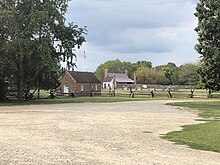Ferry Farm
In July 2008, archaeologists announced that they had found remains of the boyhood home, which had suffered a fire during 1740, including artifacts such as pieces of a cream-colored tea set probably belonging to George's mother, Mary Ball Washington.Archaeological finds include a spear point made over 10,000 years ago by a big-game hunter, numerous tools associated with bands of hunter/gatherers, and pottery created by native farmers.Augustine Washington held political office, owned several thriving plantations, and was a managing partner of Accokeek Iron Furnace located six miles north of Ferry Farm on a tributary of the Potomac River.Little Hunting Creek, later to be renamed Mount Vernon by elder brother Lawrence after his 1743 inheritance of the property was briefly the family home to Augustine and Mary Washington and their brood of five including his third son George, from 1735 to 1738.Ferry Farm was periodically occupied by Union Soldiers as a war campground, which military personnel used to prepare for battle.[18] In 1862, amid the Civil War, President Abraham Lincoln, familiar with Weems' Washington myths, toured Ferry Farm.Since the bicentennial celebration of George Washington's Birthday was approaching, Colbert and England thought the land would sell quickly, but there were other historical sites vying for preservation and the Great Depression finally killed their dream.This project left on the landscape the site's most visible feature—a large pseudo-Georgian building which now houses a museum, offices, and archaeological lab, which, since 2006, is viewable for visitors.Their attempts ultimately led to rezoning and a bid by Wal-Mart to buy the property and construct a large store adjacent to the boyhood site.This foundation oversees both sites as well as Augustine Washington's ironworks at Accokeek (Potomac) Furnace (1726~ 56) in Stafford County, part of the Principio Company.[2][4][21] Extensive archaeological investigations began in 2002 under the direction of David Muraca (formerly of Colonial Williamsburg) and Philip Levy of the University of South Florida.The Warrens were interested in historical preservation and kept the property in the family for nearly 30 years but they eventually sought to rezone the land as a B-1 commercial lot.Included in the purchase was a promise that the site heritage would be preserved through a columned plaza with "special tributes to George and the Cherry Tree."However, there was a large opposition including Fredericksburg small business owners, local historical preservationists, and many national organizations such as Daughters of the American Revolution.The summer excavations are led by Philip Levy (associate professor of history at the University of South Florida) and David Muraca (who previously worked at Colonial Williamsburg)."[27] Examples of artifacts that were found include spear points, stone axes, and quartz scrapers, which were used as tools for hunting.The fashionable gentlemen of the late 18th century wore a wig- the single most expensive part of the gentry-class man's wardrobe.These include the anecdote, appearing first in the 1806 edition of Weems's Life of Washington, in which a 6-year-old George barked one of his father Augustine's favorite English cherry trees with a new hatchet.

Virginia BeachVirginiaFerry Plantation HouseU.S. National Register of Historic PlacesU.S. National Historic LandmarkVirginia Landmarks RegisterStafford CountyFredericksburg, VirginiaCentral-passage houseGeorge WashingtonStafford County, VirginiaRappahannock RiverFredericksburgMary Ball WashingtonauthorsPope's CreekLittle Hunting CreekMount VernonHugh MercerAmerican Civil WarGeorge Allan EnglandGeorge Washington's BirthdayGreat DepressionmuseumBoard of SupervisorsWal-MartKenmoreElizabeth Washington LewisFielding LewisNational Park ServiceNational Historic LandmarkColonial WilliamsburgPhilip LevyUniversity of South FloridaexcavationsWalmartDaughters of the American RevolutionarcheologygentryParson Weemsanecdotecherry treeshatchetfathersilver dollarWashington's birthdayList of National Historic Landmarks in VirginiaList of residences of presidents of the United StatesNational Register of Historic Places listings in Stafford County, VirginiaPresidential memorials in the United StatesNational Register of Historic PlacesSt. Martin's PressWashington familyLawrence Washington (1602–1652)Coat of armsof theWashington familyJohn WashingtonLawrence Washington (1659–1698)Augustine WashingtonBailey WashingtonLawrence Washington (1718–1752)Augustine Washington Jr.Samuel WashingtonJohn Augustine WashingtonCharles WashingtonHenry WashingtonWilliam WashingtonBailey Washington Jr.Lund WashingtonWilliam Augustine WashingtonBushrod WashingtonGeorge Steptoe WashingtonLawrence Augustine WashingtonJohn Thornton Augustine WashingtonGeorge Corbin WashingtonBushrod C. WashingtonPeter Grayson WashingtonLawrence Berry WashingtonLewis WashingtonBenjamin Franklin WashingtonWilliam D. WashingtonEugenia WashingtonW. Selden WashingtonAbingdonArlington HouseBeall-AirBlakeleyCedar LawnClaymont CourtFairfieldGeorge Washington Birthplace National MonumentHappy RetreatHarewoodMary Washington HouseRichwood HallRidgedaleRising Sun TavernRiver FarmSulgraveWashington Old HallPresident of the United StatesSenior Officer of the ArmyContinental ArmyDelegateSecond Continental CongressFirst Continental CongressMilitary careerRevolutionary WarFrench and Indian WarJumonville GlenBattle of Fort NecessityBattle of the MonongahelaForbes ExpeditionWashington in the American RevolutionCommander-in-chief, Continental ArmyAides-de-campWashington's headquartersoffice and sleeping tentBoston campaignSiege of BostonNew York and New Jersey campaignDelaware River crossingBattle of TrentonBattle of the Assunpink CreekBattle of PrincetonPhiladelphia campaignBattle of Brandywine
